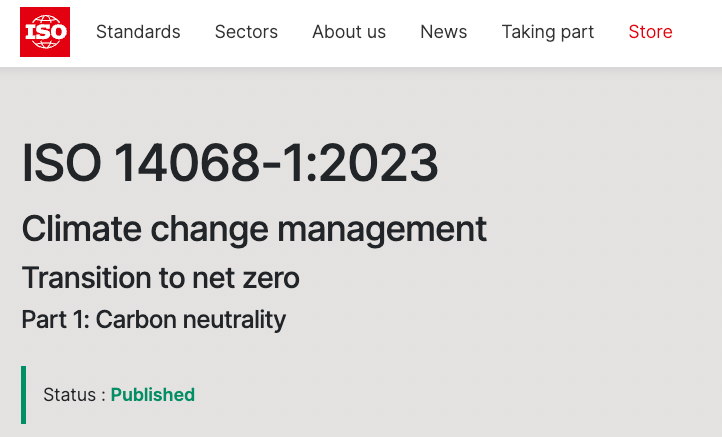Although the term "carbon neutrality" has not been around for long, it has already sparked a massive wave of low-carbon development both domestically and internationally. However, due to inadequate understanding of carbon neutrality and the continuous emergence of greenwashing incidents, many enterprises perceive carbon neutrality as a thorny path.
In November 2023, the International Organization for Standardization (ISO) introduced the latest international carbon neutrality standard, ISO 14068-1:2023, providing new insights for enterprises to strategically implement carbon neutrality.
So, how should enterprises understand this carbon neutrality standard to avoid the risks of greenwashing? What controversial issues does this standard address? Where will the future of carbon neutrality trend, and how should enterprises respond?
The ISO 14068-1 standard brings new perspectives for enterprises to address carbon neutrality challenges
In recent years, with increasing attention from the public, businesses, and government agencies on climate change and greenhouse gas emissions, "greenwashing" has gradually entered the public eye, becoming a roadblock for enterprises aiming to achieve carbon neutrality goals. Some companies even choose "greenhushing" to avoid low-carbon scrutiny and criticism, remaining silent about their sustainability efforts, despite making commendable progress in this area. One of the main reasons for this phenomenon is the lack of internationally recognized authoritative carbon neutrality standards. The introduction of ISO 14068-1 carbon neutrality standard provides enterprises with new solutions to avoid "greenwashing".

Compared to other standards, ISO 14068-1 provides groundbreaking clarity on three controversial issues regarding "carbon neutrality" - carbon neutrality work procedures, emission reduction pathway planning, and carbon offsetting. In simple terms, ISO 14068-1 instructs enterprises on how to conduct carbon neutrality work, plan carbon neutrality implementation pathways, and achieve carbon neutrality through carbon offsetting.
Carbon offsetting—turning controversy into opportunity
Previously, due to criticism and challenges from environmental activists or organizations, many companies have chosen not to achieve carbon neutrality through carbon credits. For example, Nestlé in the food industry, Gucci in the luxury goods industry, and easyJet in the aviation industry.

Why is using carbon credits to offset carbon emissions subject to scrutiny?
Company A is an example where using carbon credits to achieve "carbon neutrality" is subject to scrutiny. Let's say Company A generates 1 million tons of carbon emissions per year. In an effort to create a positive corporate image, they purchase 1 million tons of carbon credits, claiming to achieve "carbon neutrality," and promote themselves as environmentally friendly. However, in reality, the company's actual carbon emissions remain unchanged, and its environmental impact is not reduced at all. Therefore, it faces criticism and is considered to be engaging in greenwashing.
Here's another example that can be verified through the ISO 14068-1 carbon neutrality standard. Company B also emits 1 million tons of carbon emissions per year. However, Company B not only conducts annual corporate carbon audits, sets scientifically-based carbon reduction targets, and develops carbon neutrality management plans, but it also reduces 700,000 tons of carbon emissions annually through measures such as using renewable energy, process improvements, and upgrading carbon management. The remaining 300,000 tons of carbon emissions are offset through the purchase of carbon credits to achieve carbon neutrality. In summary, Company B first implements carbon emissions reduction measures and then achieves carbon neutrality through the high-quality offsetting of carbon credits, rather than simply using money to "buy green“.
By adopting the scientific standards and methods of ISO 14068-1, companies can turn potential greenwashing risks into opportunities for development and embrace carbon neutrality in a scientifically sound manner.
Future Trends in Carbon Neutrality Development—Carbon Footprint Becomes Core and Link"
During the practical implementation of carbon neutrality in enterprises, product carbon neutrality is often the most scientific and prudent entry point. This is because product carbon emissions are a major component of corporate carbon emissions, and product carbon footprint (product carbon emissions) is easier to calculate and manage compared to carbon emissions at the corporate level. Furthermore, since the product carbon footprint requires calculating the carbon emissions generated throughout the product's entire lifecycle (from raw material acquisition, production manufacturing, transportation distribution, product use to recycling disposal), and the process of upstream supply chain companies delivering products to downstream companies actually involves transmitting the product's carbon emissions, the product carbon footprint is also the basis for understanding and reducing supply chain carbon emissions.
In addition, to implement China's "dual carbon" development strategy, relevant government departments have successively issued policy documents related to carbon footprints. For example, in October 2023, the State Administration for Market Regulation issued the "Implementation Opinions on Coordinating the Use of Quality Certification Services for Carbon Peaking and Carbon Neutrality Work," and in November 2023, the National Development and Reform Commission and other departments issued the "Opinions on Accelerating the Establishment of a Product Carbon Footprint Management System," proposing to establish a dual carbon certification system, improve key product carbon footprint accounting methods, rules, and standard systems, and promote the construction of a product carbon labeling certification system.
Carbon footprint has become the core and link for enterprises to achieve carbon neutrality. Enterprises should make good use of the ISO 14068-1 standard and leverage policies such as "bringing in" international rules and "going out" with local certification advocacy to enhance the level of product carbon footprint management, accelerate the construction of green and low-carbon supply chains, and truly achieve carbon neutrality in a scientific, orderly, and genuine manner.
For readers' better understanding and use of the standard, as supplementary reading, please click on "The impact of the newly released international Carbon Neutrality Standard (ISO 14068-1) on enterprises?" to learn more about standard usage considerations.